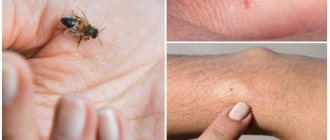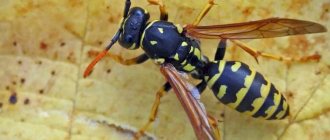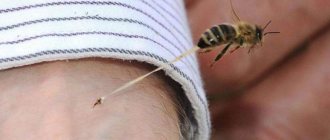The long-awaited spring and summer give an unforgettable vacation or just a well-spent weekend in nature, surrounded by flowering gardens and fruit trees. Healthy, sweet gifts of nature can be marred by a bee sting. For some it is just temporary discomfort, for others there are serious consequences. Risk groups include children and allergy sufferers. It is better to protect yourself in advance by following simple rules than to treat the consequences of bites.
Why can they sting?
A distinction must be made between aggression and defense. Bees attack people only if they feel threatened.
But it is important not only to know when and how bees bite. You must know how to behave around insects. Knowing the reason for their attack, you can avoid it. The main rule is to remain calm and avoid sudden movements. In most cases, the insect flies away.
The worst option is to wave your arms, trying to drive away the bee. If it sits directly on the body, do not wait for the bite, crush the insect or, even better, knock the insect down with a blow of your nail. This will prevent the major effects caused by the movement of venom from the poison sac into the wound. If a bee lands in your hair, crush it immediately. Don't try to get her.
Essential Information About Bee Stings
To understand how to act correctly, you need to know the following. The bee's sting is connected to a special reservoir in the bee's abdomen containing venom. When bitten, the serrated sting usually gets stuck in the skin and breaks off.
Often, along with the sting, a sac with poison attached to it remains, and the poison continues to enter the bloodstream even after direct contact with the bee has been interrupted. That is why it is necessary to remove the sting from the wound, do it quickly and very carefully, so as not to inject the poison from the sac into the bite site.
Bee venom has an acidic reaction (unlike wasp venom, which has an alkaline reaction), so alkalis - liquid soap, soap solution, baking soda solution - help neutralize it.
First aid
The first thing to do after a bite is to pull out the sting ! By hand or with tweezers - it doesn’t matter, the main thing is to do it as early as possible. The longer the sting remains in the skin, the more poison will enter the epithelium and blood. However, you should be extremely careful, since a bag of poison remains along with the sting. Carefully remove the sting with the bag without pressing on it. If you have tweezers on hand (there are always eyebrow tweezers in a woman's purse), use them.
First aid for a bee sting at home:
- Remove the sting with tweezers or your fingers, carefully pulling it out of the wound.
- Apply something cold: ice, a clean, wet cloth, or a bottle of water. Cold will help “calm” the wound and stop the development of swelling.
- The next stage is disinfection. You can use an alcohol-based antiseptic, peroxide or iodine solution.
- If you have some kind of anti-allergic remedy in your home medicine cabinet, great. Hydrocortisone ointment (1%) (pharmacy names: “Cortade” , “Lokoid” , “Hydrocort” and others), “Psilo-balm” or is suitable . Apply the bite area according to the instructions.
- To be sure, you can take an antihistamine tablet to prevent an allergic reaction.
Healthy! To understand how the body reacts to a bee sting, drink water, tea or compote. At least 300 ml. If the general condition does not worsen within 20-30 minutes, then there is no allergy.
If a bee stings you in nature, far from home and a home medicine cabinet, you can use the following to disinfect and relieve pain:
- a bottle of cold water;
- saline or soda solution;
- soap;
- olive oil;
- a piece of raw potato;
- You can also anoint the bite site with the juice of plantain, parsley or onion.
Consequences of a bee sting (allergies)
Composition of bee venom
Bee venom is secreted by special glands of the insect and is intended to protect against enemies. The poison is produced by insects consuming pollen. It tastes bitter and has a pungent odor that can be smelled by a bee sting.
Most of the composition of bee venom consists of protein substances, which are divided into enzymes and peptides. Enzymes provide sensitivity to venom enzymes. These protein substances are dangerous for allergy sufferers. Peptides, on the contrary, stimulate hormonal, protein, fat, mineral and water metabolism in the body.
Bee venom contains acids - hydrochloric and formic, which dilate blood vessels and lower blood pressure.
Composition of bee venom:
- phosphorus, magnesium, calcium and copper – 33.1%;
- carbon – 43.6%;
- hydrogen – 7.1%;
- phospholipids – 52%;
- glucose – 2%;
Benefits of bee venom
The beneficial properties of bee venom have been known for a long time. With the help of this natural remedy, many pathologies are treated, which is explained by the large number of useful components included in its composition:
- Apamin - regulates the functioning of the central nervous system.
- Hyaluronidase - promotes wound healing and eliminates adhesions.
- Phospholipase - prevents the formation of blood clots.
If there is no acute allergic reaction to bee venom, then the benefit is undoubted, and the consequences of the sting can be eliminated very quickly.
Bee sting, benefits and harm
So, we still got a painful prick from a bee. It should be mentioned here that bee venom can have not only a negative effect on the human body when stung.
Possible consequences of a bite.
For quite some time now, medicine has discovered the beneficial properties of the penetration of certain chemical substances of bee venom into the blood, among these properties we note the following:
- improvement in heart function;
- successful fight against hypertension in the early stages;
- relieving inflammatory processes inside the body;
- treatment of radiculitis;
- fight against sleep disorders, neuralgia, depression, nervous exhaustion.
And this is not surprising, because bee venom contains substances such as phosphorus, magnesium, calcium, various acids, proteins and carbohydrates, as well as amino acids and peptides. It is the presence of amino acids in its composition that makes it possible to use bee venom in such a separate area of medicine as apitherapy
.
One can reasonably ask why this seemingly useful process is accompanied by such unpleasant pain, why the sting site swells and hurts, and we usually, instead of joy, look for a way to relieve swelling after a bee sting.
Bee venom contains a substance called histamine in a decent amount.
This is a biologically active substance that, when released into the blood, has a rapid and quite strong effect on many body systems. It is this chemical compound that causes many pathological conditions, including allergic reactions.
Therefore, in addition to other components of bee venom that cause unpleasant itching and inflammation at the site of the sting, it is the body’s allergic reaction to a sting that can lead to the most unpredictable consequences.
After all, it has happened more than once that adults and seemingly healthy people who were stung by a bee while relaxing in nature ended their day in the intensive care unit of the nearest clinic. Death from a bee sting is not uncommon. After all, few people know how the body’s immune system will react to the penetration of such an antigen in the composition of bee venom as histamine.
First aid for a bee sting
In folk medicine, it is believed that bee stings are good for health; there is a whole section of medicine - apitherapy, which is devoted to the treatment of various diseases with bee venom. However, a bee sting, in addition to being very painful, can cause an allergic reaction - which is why it is necessary to know how to provide first aid.
Providing first aid for a bee sting
So, after a person has felt a sharp burning pain from a bee sting, the following must be done:
- Carefully examine the bite site, which looks like a red spot (papule) raised above the skin - a sting should be visible in the center. If it is not there, two options are possible - either the sting is inside the wound, or the victim was stung by a wasp;
- The sting must be removed. This can be done with tweezers or fingernails. If the sting is in the wound, it should be squeezed out, and you should continue to squeeze until a drop of blood appears from the wound - this way you can remove most of the poison. You can use a regular sewing needle to remove the sting, but before use, the needle must be heated over a fire or treated with an antiseptic. The wound should also be disinfected;
- Treat the bite site with an antiseptic - any one you have on hand will do;
- Apply cold to the bite site. Any cold object will do, but it is important that it is clean, otherwise there is a risk of infection;
- Apply to the wound for 15-20 minutes a piece of bandage or cotton wool soaked in a soda solution (1 teaspoon of soda per glass of water), a compress with soda slurry (add a few drops of water to a teaspoon of soda and stir until it becomes pasty);
- The bitten area can be treated with a local antihistamine (anti-allergic) agent, for example Fenistil in gel form or Psilo-balm;
- Take an antihistamine orally. This first aid measure is necessary if the body’s reaction is too violent (the appearance of general symptoms, suffocation, skin rash, swelling, enlarged papule, etc.), if the victim is prone to allergies (without waiting for its symptoms), and also in children under 12 years of age.
We organize the wintering of bees in omshanik correctly
It is also recommended to give the victim plenty of fluids - water, sweet tea, compote, etc. in order to reduce the concentration of poison in the body and speed up its elimination.
As a rule, the listed actions are enough to relieve pain and prevent possible unpleasant consequences of a bite.
Why remove the sting and how to remove it
The little worker bee has an individual defense mechanism. It includes a stinging “needle” and associated venom glands. In a calm state, the tip is hidden in its body. When in danger, it pierces the enemy.
If the opponent is another insect, then such a “duel will not be fatal for the honey miner. During interaction with animals and humans, its small barbs pierce the victim. The bee escapes, leaving part of the glands at the opposite end of the “weapon”, dying in the process.
Removing the sting from the skin
The longer the “poisonous defense instrument” is under the skin, the deeper it penetrates, the more the amount of poison entering directly into the blood increases. Troubles are also increased by the risk of inflammation of the bite site due to the presence of a foreign body in the skin.
The sting has acquired a certain appearance and functionality during evolution. In its place, “prehistoric” bees had a tube through which they laid eggs.
When medical help is needed
2% of people have an allergic reaction to bee stings. This means that under certain conditions, bee venom entering their body can cause a severe reaction, even death. In this case, first aid measures are not enough and emergency medical care cannot be avoided. Bites to some particularly vulnerable areas of the body are also particularly dangerous.
Urgent medical attention is required in the following situations:
- Multiple bites. In this case, a high dose of bee venom can lead to the most severe consequences, including respiratory arrest;
- Bites in the neck, mouth, eyes. In the first two cases, suffocation is possible due to swelling of the tissues of the upper respiratory tract; bee stings in the eye area can cause severe inflammation;
- Having an allergic reaction to the bite. The following symptoms should alert you: the appearance of shortness of breath, soreness and/or spasms in the throat, a feeling of constriction in the chest, as well as massive swelling, rash, nausea, vomiting, difficulty breathing, loss of consciousness.
In all of these cases, you should call an ambulance, or take the victim to the hospital yourself as soon as possible. You should also consult a doctor if pain, swelling and redness at the site of the bite do not decrease within three days.
Allergy to bee sting
Signs
People allergic to bees should exercise caution and seek immediate medical attention if signs of an allergy occur. A severe allergy to a bee sting manifests itself:
- in the form of redness on the body and at the site of the bite. Redness is accompanied by itching, symptoms resemble urticaria;
- increased heart rate;
- headache, pain in joints and lower back;
- swelling of the face;
- increased temperature;
- chills;
- nausea and vomiting;
- shortness of breath and difficulty breathing;
- convulsions and loss of consciousness.
After a bee sting, allergy symptoms may appear within 1-3 days.
How long can a tumor last?
On the second day after the bite, with high-quality treatment, the size of the tumor decreases, swelling becomes less, and pain is eliminated. However, if a severe allergic reaction is present, symptoms may persist for a week.
https://youtu.be/05sm588-c30
What is the best way to smear the tumor?
If a person who has been bitten by a bee feels very itchy, it is recommended to anoint the bite site with special ointments or gels that will help relieve swelling and an allergic reaction. What to apply to a bee sting? There are many ointments that can relieve such an unpleasant sensation as itching:
If the affected area has already begun to itch, this means that an allergic reaction has begun. Therefore, in addition to ointments that are applied to the bite site, the victim must take antihistamines in tablets or drops.
First aid for severe allergies: urgent actions
A bee can cause particular harm to a person who is allergic to stings. In this case, you should immediately call emergency help. Before her arrival you must:
- remove the sting;
- treat the wound with an antiseptic and apply a cold compress;
- give a double dose of antihistamine.
How to help an allergy sufferer and a child
If a child is injured by a bee, the first aid in this case is to calm him down. Especially if this happens for the first time, it can be very frightening for the baby. Try to remove the sting by scraping the side with your fingernail, then gently squeeze the venom out of the wound.
Instructions for using Stimovit for bees
Cool the affected area using one of the special gels available.
If a child has suffered many bites, more venom may enter their body. In this case, remove clothing from the affected area and wrap it in a damp, cool sheet. Contact your doctor immediately.
In case of an allergic reaction, the use of an antihistamine such as Zyrtec or Claritin is recommended.
Children after a bee sting
People who have a severe reaction and are at risk of anaphylactic shock should always have the injection prescribed by their doctor with them. It should be applied immediately after a bee sting into a muscle. Most often this is an injection containing a dose of adrenaline.
If the patient gets worse: what to do while the doctor is on the way?
In most cases, bee stings are not dangerous, and the human body reacts to their venom only with local redness, pain and the appearance of swelling. If you follow the above rules of first aid, all unpleasant sensations will be neutralized within 1 day. However, up to 5% of people are prone to general reactions to bee stings, which are expressed as follows:
- severe itching and rapidly growing area of redness;
- acute urticaria in the form of blisters and rashes all over the body;
- severe swelling of the skin and mucous membranes;
- difficulty breathing and rapid heartbeat;
- marked decrease in blood pressure, loss of consciousness;
- feeling of internal heat, malaise, weakness.
All of these symptoms indicate the development of anaphylactic shock, a condition that requires immediate use of a hormonal anti-inflammatory drug. A person’s life largely depends on how timely it is administered, so it is important to follow the correct sequence of actions (all dosages are indicated for an adult):
1. Apply cold to the bitten area for at least 10 minutes.
2. Limit the entry of the allergen into the general bloodstream by applying a pressure bandage to the limb or pressing with your hand on the site of the bee sting.
3. Inject intramuscularly a hormonal anti-inflammatory drug: Prednisolone (1 ml ampoule with 30 mg of active substance) or Dexamethasone (4 mg in 1 ml).
4. Give a drink or also inject an antihistamine - Loratadine (1 tablet 10 mg), Cetirizine (same dosage), Suprastin (25 mg), Tavegil (1 mg).
If anaphylaxis increases, and the patient has shortness of breath, coughing, and it becomes difficult for him to speak, immediately administer Adrenaline (the same as Epinephrine - a drug in 1 ml ampoules with 1 mg of the substance). It will stimulate the cardiovascular system, reduce swelling of the respiratory organs, increase blood pressure and allow the victim to wait for comprehensive drug treatment in the hospital.
Medicines for bee stings
Traditional medicine offers many drugs to help cope with the consequences of bee stings. Among them are the following:
Fenistil
Since a bee sting can cause a severe allergic reaction, you should immediately take any medications that can block the manifestation of allergies.
Fenistil is a drug of the latest generation, which not only prevents the development of an allergic reaction, but also relieves inflammation, itching, redness, and swelling. This medicine has some disadvantages. For example, it has a sedative effect on the central nervous system.
Fenistil is a colorless and odorless product, so not only adults, but also children can use it without any problems. It is quickly and completely processed in the human body.
Among the side effects are the following:
- Headache;
- Drowsiness;
- Decreased blood pressure;
- Skin rashes, etc.
Zyrtec
Available in the form of drops and tablets. It is eliminated from the body very quickly, and accordingly, it quickly affects human organs and systems. Can be taken by children over 6 months in the form of drops.
Tablet forms are allowed for use from the age of 6 years. Compared to the previous drug, Zyrtec has more contraindications and side effects. But they appear quite rarely, and it acts faster.
Tsetrin
A strong drug that is common for stings of wasps, bees, bumblebees and other insects. Begins to act within 15 minutes after application. The effect lasts for 3 days from the moment of administration.
It can be used for a long time, as it does not affect the central nervous system. It can be taken both before and after meals. Available in drops, tablets and baby syrup. If a severe allergic reaction develops, Cetrin can be taken for two weeks. Side effects are extremely rare.
A bee sting is quite painful for both children and adults. But, knowing the basic rules of first aid, you can help avoid unpleasant consequences for yourself, your children and your friends.
Important to remember! Bees, unlike wasps, leave a sting at the site of the bite. This sting must be urgently removed.
Bee sting symptoms
Immediately after a bee sting, severe pain begins with a characteristic burning sensation. As a rule, a bee sting remains at the site of the bite, which needs to be removed. Swelling forms quite quickly. Its size largely depends on how well your body tolerates the influence of various poisons and toxins. Typically, swelling and pain go away after a few hours, but in some cases, a bee sting can cause a severe allergic reaction . That is the problem.
It is especially bad when a bee bites a child whose body is not yet accustomed to poisons and toxins. And if a bee stings you on the face (lips, cheeks, eyes) or on the neck, then it is better to immediately contact the nearest medical center.
Important! The recommendation to see a doctor is not an empty call! Timely medical attention can save lives, especially in cases of severe allergic reactions to bee venom.
When a child gets stung by a bee
Folk remedies for bee stings
- Parsley – has anti-inflammatory properties. Scald the parsley leaves with boiling water and place them in a glass of boiling water for five minutes. Then apply warm leaves to the bite area.
- Aloe – reduces swelling and itching, relieves redness. Using compresses with aloe decoction, or applying aloe leaves to the bite site, the wound will heal faster.
- Onion – has bactericidal properties, relieves redness and reduces swelling. Apply compresses with onion juice, or use half an onion that releases juice. Discomfort from using a folk remedy for bee stings is caused by a burning sensation and the pungent odor of onions.
- Chilled olive oil – relieves redness and reduces irritation from a bee sting. Lubricate the bite area with a small amount of oil.
- Plantain – has bactericidal and anti-inflammatory properties. The action of plantain is effective with parsley leaves placed under it.
Folk remedies
If you don’t have pharmaceutical drugs at hand, you can use one of the folk remedies:
Parsley
Chop the parsley and pour boiling water over it. After cooling, apply the leaves to the bite site to relieve inflammation and swelling. To enhance the effect, combine parsley pulp with chopped plantain leaves.
Mint and lemon balm
These medicinal herbs contain essential oils that not only help with bee stings but also repel insects. If you crush the leaves in your hands and rub them on your body, the bees will not come close to you.
Natural olive oil
Lubricate the wound with it several times every 10 - 15 minutes. This will relieve inflammation and swelling, eliminate redness on the skin.
Plantain
Wash the freshly picked leaf, mash it slightly until the juice releases and apply to the bite site.
Aloe
Cut the leaf and apply it to the wound. Aloe juice disinfects wounds, relieves swelling, and reduces pain.
Onion
Grate the onion and apply the paste to the bite.
Emergency help for allergy sufferers
For people with a tendency to allergies, bee stings pose a mortal danger, so the victim should not be left alone until the ambulance arrives. It is urgent to give an antiallergic injection and carefully monitor the person’s condition.
- If cardiac arrest occurs, resuscitation measures are used: indirect cardiac massage and artificial respiration . For 30 compressions in the chest area, take two breaths. You need to press with straight hands, without much effort, so as not to break the ribs and sternum. Such damage will make breathing difficult and lead to negative consequences.
- It is better to replace mouth-to-mouth artificial respiration with mouth-to-nose breathing . If there is swelling, the tongue sinks, so air will not get into the lungs. The correct ventilation of the respiratory system is checked by changes in chest volume.
Video tips for emergency help for allergy sufferers
Consequences of a bee sting
After a person is stung by a bee, swelling appears. With proper first aid and further treatment at home, it lasts about 1–5 days. It all depends on the victim’s body. In children, swelling persists for a longer period. Other manifestations of the body’s normal reaction to a bee sting:
- hives;
- burning, pinching, itching in the affected area;
- rash and redness around the bite.
If the swelling does not subside within 7 days or more, you should consult a doctor. The same applies to a severe allergic reaction, which is manifested by the following symptoms:
- tremor of the limbs;
- body aches;
- lacrimation;
- cough;
- shortness of breath;
- difficulty breathing;
- bronchospasm;
- increased heart rate;
- increased sweating;
- nausea, vomiting;
- headache;
- dizziness.
Bee stings to different parts of the body
An insect can bite anywhere, anywhere on our body, and this will not be a pleasant incident, but it will not be fatal either, unless you are allergic to bee venom.
If a bee has bitten you on the lip, then the first thing you need to do is take a suprastin tablet, and then apply something cold to your lip, and if there is no such thing, then lubricate the bite site with “Rescuer” cream, which should be in the first aid kit of every person on nature. If you are allergic to bee venom, you should immediately consult a doctor.
When a bee stings the tongue, if a person is allergic, there is a risk of laryngeal edema, so you should immediately seek medical help. This is especially necessary if a person does not know how to react to a bee sting. If there is no allergy, then you need to take an anti-allergy pill, which will relieve the swelling in a couple of days.
When a bee stings your eye, what should you do? You can’t joke with the eyes, since they are located close to the main mucous membranes, and swelling of the eyelid can affect areas of the face and neck, causing not only blurred vision, but also suffocation, therefore, in case of a bite in the eye, you must urgently seek medical help.
If a bee stings your head, self-medication is strictly prohibited. A bee sting to the head can cause the most serious consequences. In this case, you must immediately take the victim to the emergency room or emergency room.
How to prevent yourself from being bitten
There are several simple rules that will help prevent a bee attack:
- If an insect flies too close, you should not drive it away with your hands. You need to stand still and not twitch until the bee flies away;
- try not to be afraid, since these insects, according to some scientists, feel when adrenaline is produced;
- do not wear bright clothes that may attract bees that are accustomed to identifying flowers in this way;
- avoid odorous deodorants and perfumes that attract insects;
- do not walk barefoot on the grass.
To prevent an incident, you need to remain calm and not panic when you see a bee. After all, these insects never attack first.
The most important rule is to under no circumstances wave a rolled-up newspaper or fly swatter at a bee if it has flown indoors. You just need to open all the windows and wait for the insect to fly away. Flying around a bee family in a greenhouse in spring
How to protect yourself from bites
Bee stings can be prevented by following a few simple rules:
- Do not appear at the apiary or at the place where nectar is collected in dark clothes and with a strong smell of perfume, tobacco, alcohol, or sweat;
- Wear protective clothing while extracting honey;
- Do not scream, wave your arms or run away when you encounter a bee;
- Do not touch a striped insect if it has landed on the body or is tangled in the hair;
- Do not eat or drink anything sweet or sweet-smelling when visiting places with apiaries or honey collection;
- Try not to get close to buckwheat fields while collecting honey. The weak production of nectar by buckwheat makes striped insects very aggressive;
- Do not walk barefoot or wear loose clothing near apiaries.
Having primary information on how to avoid a bee sting and what to do if it does sting will help you protect your health when visiting places with a nearby apiary or mass collection of nectar.
Bee sting to head, neck, arm
A bite to the head or neck is much more dangerous than a bite to the arm or leg, for example. So, if an individual reacts normally to bee venom, then in this situation the degree of allergization increases.
Exacerbation of symptoms is due to the presence of a large number of blood vessels, including large ones, lymph nodes, nerve endings and vital points. As a result of a sting in the neck or head, severe weakness, rapid heartbeat and breathing, development of fever, urticaria, neuritis, convulsions and even Quincke's edema are possible.
Seek specialized medical help immediately.
Bee venom getting into the eye
A bite to the eyelid, at first glance, does not threaten anything other than swelling. The eye may become swollen. The consequence can be severe diseases of the eye apparatus, which cause loss of vision.
These include inflammation of the eyelids, mucous membranes, purulent inflammation of the eye tissues, cataracts and glaucoma.
Swelling of the eye when bitten
If such a dangerous situation arises, you cannot hesitate, use traditional methods and hope that “it will go away on its own.”
Treatment and observation by a professional ophthalmologist.
How to relieve swelling and swelling
A bite to other parts of the body is not so dangerous, but the consequences are purely individual. In addition to the harm that bee stings in the facial area entail, it also causes a number of cosmetic problems.
Severe swelling of the lip, nose, cheek, chin, and ear occurs with a corresponding “wound.” Trouble forces you to postpone meetings and events. The situation with the female gender is especially painful.
On average, the swelling lasts 2-3 days. Its reduction entails unpleasant itching, as when healing any other wound.
Timely use of an appropriate cold compress helps , alternate use of several local antipyretics (for example, alternating alcohol lotions with soda), ice, antihistamines and anti-inflammatory folk remedies (for example, herbal tea) reduces the degree of swelling and speeds up recovery.
Complications from a bee sting
Timely provision of correct first aid and going to the hospital can prevent serious consequences from a bee sting:
- If severe allergy symptoms occur, especially with bee stings on the neck, eyes, face, or ear, immediately call an ambulance or take the victim to the hospital.
- If previous bee stings have caused an allergy, give the victim an allergy medication and take him to the hospital.
- If there are more than 10 bee stings on the victim’s body, call an ambulance immediately.
- If signs of infection appear at the site of the bite: pain intensifies, body temperature rises, call an ambulance and give the victim plenty of fluids.
How to relieve swelling from a bee sting on the second day
If the swelling has not been treated for more than a day, then it will be a little more difficult to quickly get rid of it. Here you will have to use antiallergic drugs in the form of ointments and tablets. Traditional recipes - baths, lotions and the like will also not hurt, but you need to make sure that they do not cause more harm.
Drug treatment
Medicines can be prescribed both local and systemic. They are prescribed based on the presence of a generalized allergic reaction. Doctors prescribe the following types of medications:
- Glucocorticoids.
- Antihistamine tablets.
- Parenteral glucocorticoids.
What not to do when helping with a bee sting
It is widely believed that bee venom is easily neutralized by alcohol taken orally, so you can often find advice to drink 30-50 g of vodka or cognac if you are stung by a bee. For obvious reasons, this “treatment” is not suitable for children, however, adults should not do it either. The fact is that alcohol does not remove or neutralize toxins, but, on the contrary, facilitates their penetration into the body and complicates their elimination.
Also, when providing first aid, you do not need to do the following:
- Rub the bite site and press on it (with the exception of squeezing the poison out of the wound, i.e. pressing in a special way);
- Apply earth, clay to the wound, wash and cool it with river, lake water or water from puddles. This is likely to lead to infection, including tetanus;
- Kill a bee. Firstly, a bee left without a sting dies itself. Secondly, if it is crushed, special volatile substances are released that notify nearby bees of danger. This can attract a lot of other bees towards you, angry and ready to attack.
The benefits of bee stinging. How does it help?
The substance called bee venom has certain benefits and is represented by the composition of a large number of elements:
- proteins;
- peptides;
- amines;
- lipids;
- amino acids;
- pheromones;
- carbohydrates;
- fats;
- mineral components.
Treatment with bees
The development of allergies is influenced by certain proteins (hyaluronidase and phospholipase), amines (histamine), and peptides (melityn). At the same time, these components, along with the others, have a beneficial effect on the human body. Each of them has different properties.
Benefits of bee stinging
If a bee stings a person, it can be harmful and even dangerous to health. But if the stings occur in the right place, it can have a positive effect. The fact is that the complex composition of bee venom, along with a negative effect on the body, also provides a positive effect. In particular, bee venom:
- dilates blood vessels;
- reduces blood viscosity;
- stabilizes hormonal levels;
- increases the overall tone of the body.
In addition, when targeted, the substance helps in the treatment of diseases of the musculoskeletal system.
Apitoxin therapy (treatment with bee venom) is one of the main methods of apitherapy (treatment with bee products). It is very important to remember that treatment with bee venom can only be carried out by a qualified specialist if the patient has no contraindications.











